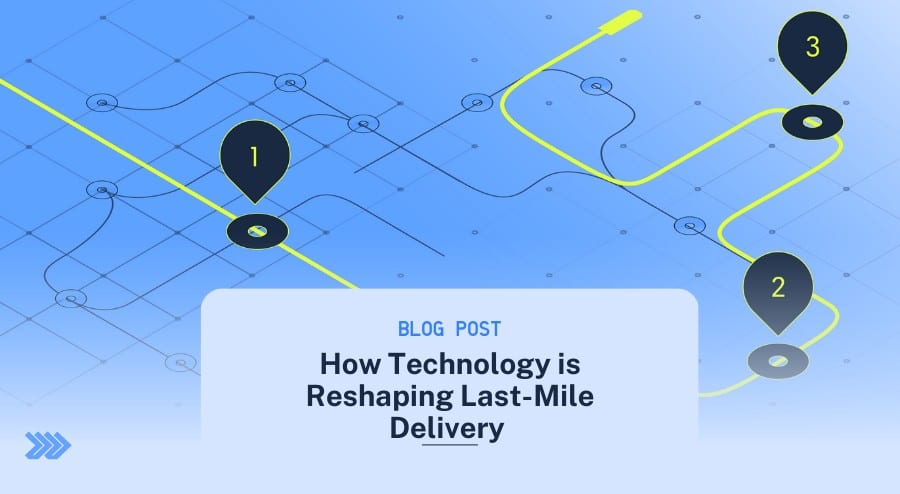How Technology Is Reshaping Last-Mile Delivery

Wise Systems

Last-mile delivery, sometimes referred to as “final-mile delivery,” represents the most complex and costly leg in a package’s journey to a consumer. People have been buying goods and receiving packages for centuries, but the meteoric rise of e-commerce over the past decade has drastically increased delivery demand and created new pressures on an already stretched industry. And with that demand comes new challenges.
As part of their efforts to optimize last-mile operations, carriers have been exploring emerging technologies to help them deliver packages more efficiently and cost-effectively. Modern last-mile delivery technology has the potential to truly reshape the way that carriers get packages into the hands of consumers, and we’re going to explore some of that tech here.
But first, let’s dive into the ins and outs of last-mile operations.
What Are Last-Mile Operations?
The term “last-mile operations” refers to the various processes and procedures involved in getting a product from a regional distributor/receiver to the consumer or business that purchased it. Any product delivered to a buyer must navigate a long journey that typically includes a manufacturer, receiving facility, regional distributor/fulfillment center, and then a last-mile carrier.
Last- or final-mile delivery is the final link in that chain. For instance, let’s say you order a product that is manufactured overseas, shipped to a domestic port in Florida, and then routed to a regional distributor in your home city. That product would complete the final mile of its journey when a carrier picks it up at the distribution center and drops it off at your doorstep.
While this last-mile delivery example makes the process sound simple, it is anything but. During a last-mile delivery, carriers have to contend with unruly variables like staffing availability, ever-changing traffic conditions, unexpected disruptions, and unpredictable weather — just to name a few. These factors can all cause delivery delays, missed deadlines, and customer frustration.
Why Is There a Need for Last-Mile Delivery Innovation?
Last-mile operations account for approximately 50% of total delivery costs. They represent the largest single opportunity for carriers to reduce operating expenses while also enhancing the customer experience.
Simply hiring more drivers or purchasing additional vehicles might seem like a viable option, but it’s not a very cost-effective solution to the last-mile problem. And it’s especially impractical if the carrier simply doesn’t have enough resources to keep up with demand.
Often, the last-mile problem boils down to inefficient management. The right last-mile delivery technology can solve these challenges.
How to Reduce Last-Mile Delivery Costs
With the right software in place, carriers can optimize routes, reduce fuel costs, expedite deliveries, and keep customers happy. Now the question is… what’s the right software for your company?
Solving a complex problem requires equally sophisticated solutions. While there’s no magic pill that solves the last-mile problem universally, you can determine which suite of complementary technologies makes sense for your unique needs.
The Most Impactful Last-Mile Delivery Logistics Solutions
Carriers can make meaningful improvements to their last-mile operations by investing in a few proven technologies, as outlined below.
Route Optimization Tools
Speaking of route planning, modern route optimization tools are forever changing the way that carriers map out deliveries. In the past, drivers would be left to plan out their own delivery routes.
While drivers familiar with their service area could likely plan out an efficient route, doing so takes time. It’s also virtually impossible for drivers to account for the multitude of variables that can impact their delivery efficiency.
Today, the role of route planning most often falls to dedicated route planners and dispatchers who use robust route optimization technologies to create route plans based on anticipated weather, traffic conditions, and trends like rush hour, road closures, and other data points. This technology creates optimized routes in seconds so planners and dispatchers can focus on improving customer service and assisting drivers.
Comprehensive Dispatching Software
While courier managers may rule the proverbial roost at a final-mile delivery facility, dispatchers hold the keys to the kingdom. They’re responsible for assigning loads, monitoring routes, tracking delivery progress, overseeing driver performance, and providing their higher-ups with the information they need to make timely decisions.
Since dispatchers juggle so many responsibilities, it’s vital that they are provided with the technology stack to support their work. Specifically, they need modern, cloud-based routing and dispatching software that gives them a bird’s-eye view of all fleet assets. Top technology solutions allow dispatchers to visualize vehicles on a real-time map, which helps them make decisions on the fly, keep drivers on time, and avoid significant delivery delays.
Empowering dispatchers with user-friendly, innovative technologies is the first step to reshaping last-mile delivery.
Driver-Facing Mobile Applications
Driver-facing mobile applications keep drivers connected with dispatchers, field personnel, fleet managers, and customers. These applications also allow drivers to access custom routes, provide proof of delivery, scan barcodes, and more. Without a user-friendly mobile app for drivers, other technology investments will make a minimal impact on last-mile delivery efficiency.
Last-Mile Delivery Automation Technologies
If hiring more drivers isn’t the answer to your last-mile problem, expanding auxiliary departments won’t be either. Many last-mile carriers have caught on to this and are now working to maximize the productivity of their existing teams, replacing antiquated manual processes with automated alternatives.
Last-mile delivery automation technologies either partially or completely automate otherwise redundant processes, allowing businesses to accomplish more without bringing in additional full-time staff or overworking existing team members. A few processes that lend themselves nicely to automation include assigning loads, tracking delivery statuses, updating clients, and planning routes. As delivery volumes increase, it becomes mathematically impossible and unrealistic for even the most capable dispatchers to manage, and compromises business’ ability to grow.
Wise Systems | Plan, Execute, Coordinate & Communicate
If your organization is ready to transform last-mile operations with a suite of complementary technologies, you need a partner that understands the challenges facing your business.
Enter Wise Systems. Our portfolio of last-mile delivery solutions includes powerful and easy-to-use applications for routers, dispatchers, drivers, managers and delivery recipients. It also offers seamless API-based integrations with leading platforms to simplify your daily routing and dispatching, and improve your fleet’s customer service ratings To learn more about how our technology is transforming last-mile delivery, schedule a demo with us today.
Frequently Asked Questions
What are the challenges of last-mile delivery?
Last-mile delivery faces several challenges, including:
- Navigating congested urban areas
- Dealing with unpredictable traffic conditions
- Finding efficient parking options
- Addressing delivery time windows
- Handling the growing volume of e-commerce orders
- Managing the complexity of multiple stops
- Ensuring safe and secure deliveries
- Handling returns or failed deliveries
These daily hurdles make last-mile delivery costly, time-consuming, and logistically demanding. Many companies are turning to advanced software solutions like the Wise Systems delivery automation platform to tackle these issues and optimize last-mile delivery operations to remain competitive.
What are the key elements for effective last-mile delivery?
The foundation of an effective last-mile delivery operation is robust logistics and technology infrastructure that includes:
- A reliable and efficient transportation network
- Optimized delivery routes
- Real-time tracking and visibility
- Advanced analytics for data-driven decision-making
- Seamless communication channels among staff and with delivery recipients
- Effective inventory management
- Integration with e-commerce platforms
Additionally, customer-centricity, collaboration with local stakeholders, and continuous process improvement are essential elements of successful last-mile delivery operations.
How can last-mile delivery be made more efficient?
Last-mile delivery can be made more efficient through various strategies. These include:
- Implementing route automation and optimization software to minimize travel distance and time
- Using predictive analytics to forecast demand and allocate resources effectively
- Adopting alternative delivery modes such as drones or electric vehicles for shorter distances
- Leveraging local fulfillment centers or micro-warehouses to reduce distance and enable quicker deliveries
- Implementing smart lockers or pickup points for convenient customer self-service
- Optimizing vehicle loading and unloading processes
- Leveraging real-time data and analytics to make proactive adjustments to routes and schedules
Additionally, collaboration with other stakeholders like local authorities, businesses, and customers can also contribute to efficiency gains in last-mile delivery.





